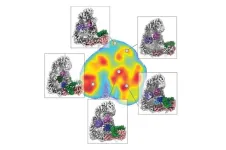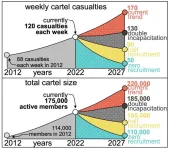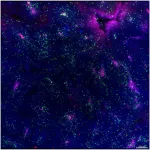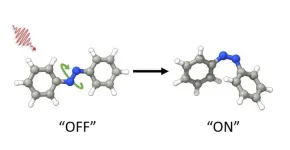(Press-News.org) Cleveland Clinic researchers have used nanoparticles to develop a potential vaccine candidate against Dabie Bandavirus, formerly known as Severe Fever with Thrombocytopenia Syndrome Virus (SFTSV), a tick-borne virus that currently has no prevention, treatment or cure.
The patent-pending vaccine uses nanoparticles to carry the antigens that contain instructions for fighting off a virus. Nanoparticle vaccines are designed to effectively deliver antigens at a lower dose with fewer side effects for at-risk groups – including adults over age 50, who are the most vulnerable to SFTSV and the most susceptible to vaccine side effects.
The pre-clinical research, published in mBio, was led by Jae Jung, PhD, Director of Cleveland Clinic’s Sheikha Fatima bint Mubarak Global Center for Pathogen and Human Health Research. “The Pathogen Center was founded to prepare for and protect against future global health crises before they start,” says Dr. Jung, who also serves as Department Chair of Cancer Biology and Director of Infection Biology. “There is already a desperate need for a SFTSV vaccine in Asia. Our goal was to develop one before it’s needed in America, too.”
The World Health Organization had declared SFTSV as needing “urgent research attention” several years ago, and it is still listed as a threat by the National Institutes of Health in the US. The virus spreads through the Asian longhorn tick, a species already present in 19 U.S. states including Ohio. It can also sometimes spread from human to human, mainly in a hospital setting.
Currently, physicians can only address the virus’s symptoms and keep infected patients hydrated and comfortable. While many people experience mild symptoms, adults over 50 years old can become severely ill and face a 30% mortality rate.
The benefits of nanoparticles
This same population unfortunately experiences certain vaccine side effects that typically don’t affect younger people.
“We become more sensitive to certain vaccine side effects the older we get,” says study first author Dokyun (Leo) Kim. “We wanted to develop a treatment that’s age-dependent and can be given safely to the people who need it the most.”
Nanoparticle vaccines are promising for treating these at-risk groups because the antigens are bundled together, instead of free-floating throughout our bodies. Because our immune cells can find “bundles” of antigens on a nanoparticle more easily, the vaccine can be effective using a lower dose. When the vaccine dosage is reduced, its potential side effects are reduced as well, according to preliminary research conducted by Kim.
Dr. Jung's lab hopes to test the SFTSV vaccine in humans, next. And Kim says the possibilities don’t end there.
“We’re working to apply our nanoparticle technology to other viruses,” he says. “We have already developed a candidate for COVID-19, and we’re not stopping any time soon.”
END
Nanoparticle vaccine candidate shows promise against emerging tick-borne virus in early studies
Nanoparticle vaccines are designed to effectively deliver a lower dose with fewer side effects for at-risk people
2023-09-21
ELSE PRESS RELEASES FROM THIS DATE:
University of Minnesota Medical School assistant professor, research team awarded $1 million grant to improve access to legal advocacy for rural and Indigenous communities
2023-09-21
MINNEAPOLIS/ST. PAUL (09/21/2023) — Michele Statz, PhD, an assistant professor at the University of Minnesota Medical School, Duluth Campus and affiliated faculty with the University of Minnesota Law School’s Human Rights Center, and her research team have been awarded a $1 million grant from the National Science Foundation’s CIVIC Innovation Challenge to improve access to civil justice for rural and Indigenous communities in Alaska. The research team aims to develop a model that can be replicated in other communities across the country.
The “Bridging the Rural Justice Gap: Innovating & Scaling Up Civil Access to Justice in Alaska” ...
Scientists reveal intricate mechanisms cells use to build protein destruction signals
2023-09-21
Within the intricate molecular landscape inside of a cell, the orchestration of proteins demands precise control to avoid disease. While some proteins must be synthesised at specific times, others require timely breakdown and recycling. Protein degradation is a fundamental process that influences cellular activities such as the cell cycle, cell death, or immune response. At the core of this process lies the proteasome, a recycling hub in the cell. The proteasome degrades proteins if they carry a molecular tag formed by a chain of ubiquitin molecules. The task of attaching this tag falls to enzymes known as ubiquitin ligases.
This process, known ...
Moms’ ability to ‘remember’ prior pregnancies suggests new strategies for preventing complications
2023-09-21
Scientists have known for decades that pregnancy requires a mother’s body to adjust so that her immune system does not attack the growing fetus as if it were a hostile foreign invader. Yet despite learning a great deal more about the immunology of pregnancy in recent years, a new study shows that the cellular crosstalk between a mother and her offspring is even more complex and long-lasting than expected.
The study was published online Sept. 21, 2023, in the journal Science by a research team led by Sing Sing Way, MD, PhD, Division of Infectious Diseases at Cincinnati Children’s and the Center ...
Curbing violence in Mexico: Disrupting cartel recruitment holds the key, a new study finds
2023-09-21
Not through courts and not through prisons. The only way to reduce violence in Mexico is to cut off recruitment. Increasing incapacitation instead leads to both more homicides and cartel members, researcher Rafael Prieto-Curiel from the Complexity Science Hub and colleagues show in a study in Science.
In 2021, approximately 34,000 people died from intentional homicides in Mexico – the equivalent of nearly 27 victims per 100,000 population. This ranks Mexico among the least peaceful countries worldwide.
FIFTH LARGEST EMPLOYER
In order to be able to address this violence ...
Rewiring tumor mitochondria enhances the immune system’s ability to recognize and fight cancer
2023-09-21
Immunotherapy, which uses the body’s own immune system to fight cancer, is an effective treatment option, yet many patients do not respond to it. Thus, cancer researchers are seeking new ways to optimize immunotherapy so that it is more effective for more people. Now, Salk Institute scientists have found that manipulating an early step in energy production in mitochondria—the cell’s powerhouses—reduces melanoma tumor growth and enhances the immune response in mice.
The study, published in Science on September 21, ...
Two studies indicate CO2 on Europa’s surface originated from within the moon’s internal ocean
2023-09-21
A pair of independent studies, using recent James Webb Space Telescope (JWST) observations of carbon dioxide (CO2) ice on Jupiter’s moon Europa, indicate the CO2 originates from a source within the icy body’s subsurface ocean. The findings from both research groups provide new insights into the poorly known composition of Europa’s internal ocean. Beneath a crust of solid water ice, Jupiter’s moon Europa is thought to have a subsurface ocean of salty liquid water. Because of this, Europa is a prime target in the search for life elsewhere in the Solar System. Assessing this deep ...
Global study reveals extensive impact of metal mining contamination on rivers and floodplains, suggesting need for new safeguards to address spike in demand for ‘green’ minerals
2023-09-21
A groundbreaking study, published today in Science, has provided new insights into the extensive impact of metal mining contamination on rivers and floodplains across the world, with an estimated 23 million people believed to be affected by potentially dangerous concentrations of toxic waste.
Led by Professors Mark Macklin and Chris Thomas, Directors of the Lincoln Centre for Water and Planetary Health at the University of Lincoln, UK – working with Dr Amogh Mudbhatkal from the University’s Department of Geography – the study offers a comprehensive understanding of the environmental and health challenges associated with metal mining activities.
Using ...
Regeneration across complete spinal cord injuries reverses paralysis
2023-09-21
When the spinal cords of mice and humans are partially damaged, the initial paralysis is followed by the extensive, spontaneous recovery of motor function. However, after a complete spinal cord injury, this natural repair of the spinal cord doesn’t occur and there is no recovery. Meaningful recovery after severe injuries requires strategies that promote the regeneration of nerve fibers, but the requisite conditions for these strategies to successfully restore motor function have remained elusive.
“Five years ago, we demonstrated that nerve fibers can be regenerated across anatomically complete spinal cord ...
The dance of organ positioning: a tango of three proteins
2023-09-21
In order to keep track of their environment, cells use cilia, antenna-like structures that can sense a variety of stimuli, including the flow of fluids outside the cell. Genetic defects that cause cilia to malfunction and lose their sensory abilities can result in disorders known as “ciliopathies”, including polycystic kidney diseases; but they can also disrupt the correct asymmetric positioning of internal organs during embryonic development – what is known as “organ laterality”.
An example of such asymmetry is the heart, which is typically ...
Using harmless light to change azobenzene molecules with new supera molecular complex
2023-09-21
New discovery allows scientists to change the shape of azobenzene molecules using visible light, which is more practical and safe than previously used ultraviolet light. Azobenzenes are incredibly versatile and have many potential uses, such as in making tiny machines and improving technology as well as making light controllable drugs. This molecule can switch between two different forms by light. However, the two forms are in equilibrium, which means that a mixture present that prevents optimal use for applications. Being able to control them with visible light and enrich only one form opens up new possibilities for these applications, making them more efficient ...
LAST 30 PRESS RELEASES:
Heart-brain connection: international study reveals the role of the vagus nerve in keeping the heart young
Researchers identify Rb1 as a predictive biomarker for a new therapeutic strategy in some breast cancers
Survey reveals ethical gaps slowing AI adoption in pediatric surgery
Stimulant ADHD medications work differently than thought
AI overestimates how smart people are, according to HSE economists
HSE researchers create genome-wide map of quadruplexes
Scientists boost cell "powerhouses" to burn more calories
Automatic label checking: The missing step in making reliable medical AI
Low daily alcohol intake linked to 50% heightened mouth cancer risk in India
American Meteorological Society announces Rick Spinrad as 2026 President-Elect
Biomass-based carbon capture spotlighted in newly released global climate webinar recording
Illuminating invisible nano pollutants: advanced bioimaging tracks the full journey of emerging nanoscale contaminants in living systems
How does age affect recovery from spinal cord injury?
Novel AI tool offers prognosis for patients with head and neck cancer
Fathers’ microplastic exposure tied to their children’s metabolic problems
Research validates laboratory model for studying high-grade serous ovarian cancer
SIR 2026 delivers transformative breakthroughs in minimally invasive medicine to improve patient care
Stem Cell Reports most downloaded papers of 2025 highlight the breadth and impact of stem cell research
Oxford-led study estimates NHS spends around 3% of its primary and secondary care budget on the health impacts of heat and cold in England
A researcher’s long quest leads to a smart composite breakthrough
Urban wild bees act as “microbial sensors” of city health.
New study finds where you live affects recovery after a hip fracture
Forecasting the impact of fully automated vehicle adoption on US road traffic injuries
Alcohol-related hospitalizations from 2016 to 2022
Semaglutide and hospitalizations in patients with obesity and established cardiovascular disease
Researchers ‘listen in’ to embryo-mother interactions during implantation using a culture system replicating the womb lining
How changing your diet could help save the world
How to make AI truly scalable and reliable for real-time traffic assignment?
Beyond fragmented markets: A new framework for efficient and stable ride-pooling
Can shape priors make road perception more reliable for autonomous driving?
[Press-News.org] Nanoparticle vaccine candidate shows promise against emerging tick-borne virus in early studiesNanoparticle vaccines are designed to effectively deliver a lower dose with fewer side effects for at-risk people







